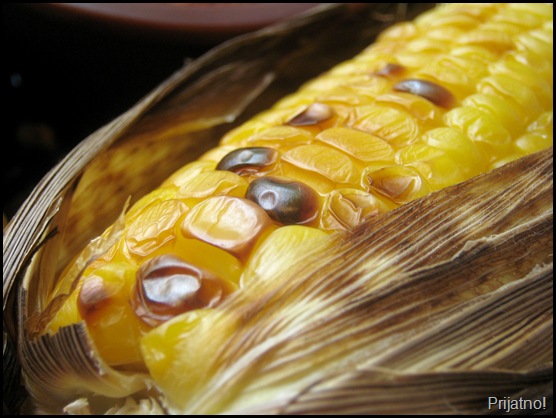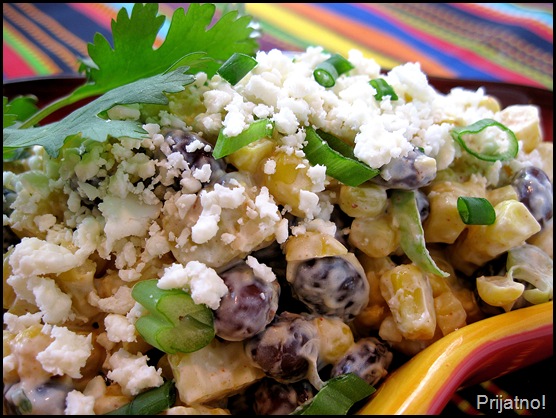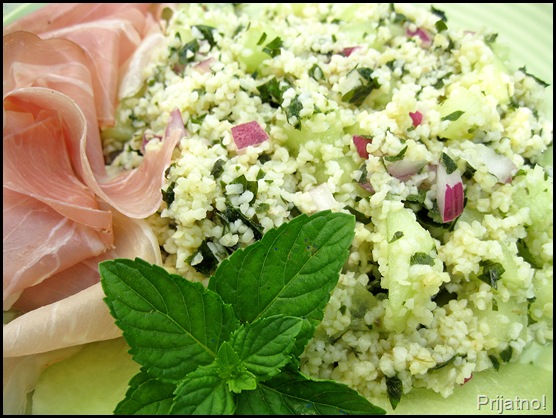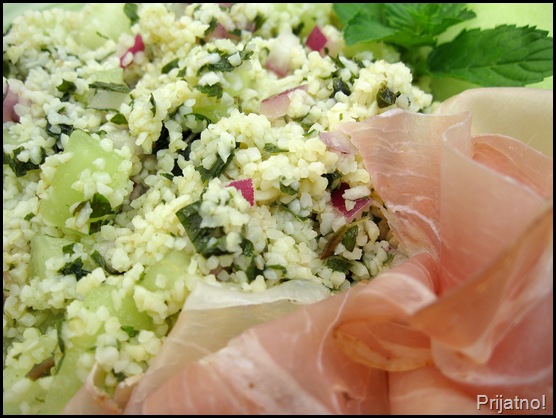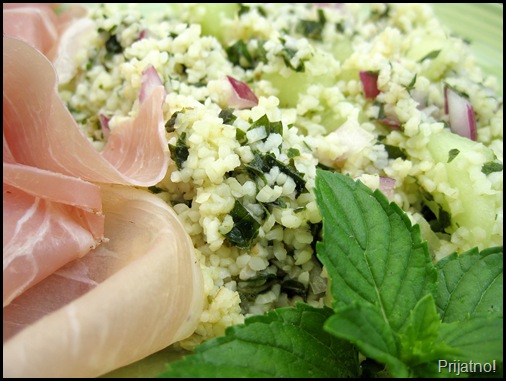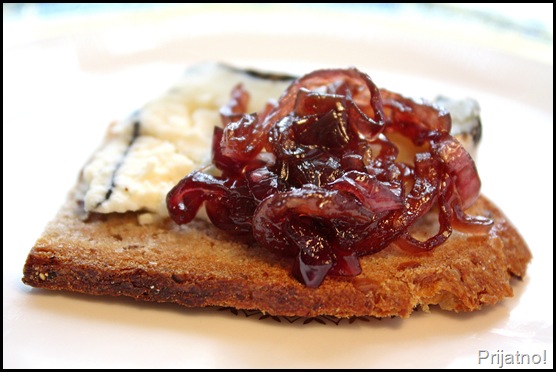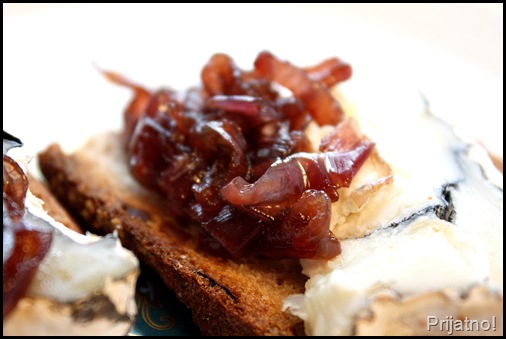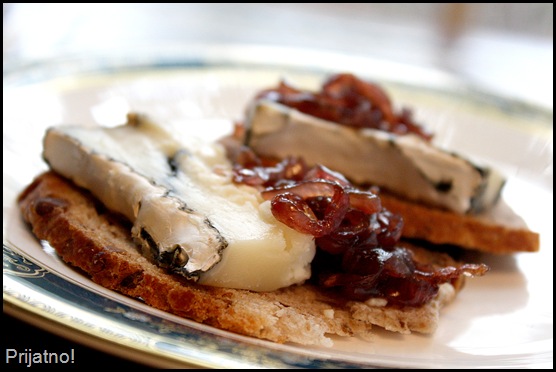
My love for goat cheese (chèvre) is no secret. I am an afflicted turophile! It’s a new word for me and probably for you as well, dear reader. It comes from the Greek tyros ‘cheese’ and philos ‘love’ and was first used by the English in the 1930s. Rarely used today, it also means ‘connoisseur of cheese’. Aside from being a dedicated turophile, I also spend way too much time on the internet where I came across an alternative/rock band based in Toledo, Ohio named Turophilie, that claims to have “no tolerance for the lactose intolerant”! I listened to a couple of songs on their playlist and quite like their sound. Interesting stuff one comes across on the internet!
Back to chèvre…Hubby and I hosted a wine dinner recently with goat cheese or goat's milk in every single course. For starters, and with the help of my accomplished wine group members, I managed to pack eight delicious tidbits on two appetizer plates. Each of the items varied in texture, flavor and color and presented a feast for the eyes!
Warm appetizer plate
Tartelettes with chèvre, red peppers and caramelized red onions
Creamy Mediterranean chèvre polenta with scallops on a half shell
Dates stuffed with chèvre wrapped in bacon
Roasted beet and chèvre tower with pistachios

Cold appetizer plate
Humboldt Fog on homemade walnut bread
Terrine of chèvre with zucchini and roasted red, orange and yellow peppers
Chèvre crème brulee with turbinado crust
Melon salad with chèvre feta and sherry vinegar dressing
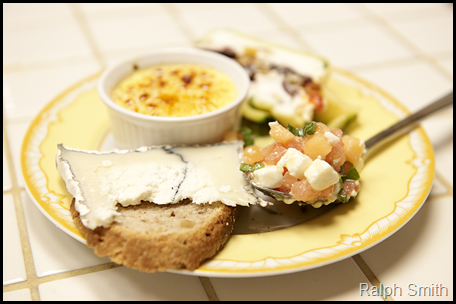
Chèvre overkill, you say? It can never happen in my world, but it was a definite challenge for Hubby in the wine pairing department. Since a few members of our group tend to steamroll toward the reds, we had to remind them that goat cheese loves to be courted by champagne, Sauvignon Blanc and Riesling. I managed to sneak some chèvre into the spinach and pine nut ‘cigars’ that accompanied the main course of grilled lamb chops with celery root and Yukon gold puree and sautéed mushrooms. We drank a few Chateauneuf-du-Pape reds and everyone was very happy. Homemade Vanilla bean goat’s milk ice cream topped individual apple tarts for dessert and we were ecstatic!
In my ‘humboldt’ opinion, Humboldt Fog chèvre rivals the best the French can produce. Made in California by Cypress Grove Chèvre, it is the epitome of American made cheese. It’s firm and chalky, thick and creamy, with an unmistakable tang derived from the acids unique to goat’s milk. The rind is edible, as well as the delicate layer of ash that runs through the middle of the cheese, giving it a pretty layer-cake look. Best at room temperature, the outer layer oozes creamy-rich decadence seen in the picture at the end of this post.
A nice complement to the chèvre is bread made with walnuts and shallots. The soft rich cream in the cheese contrasts with a hint of onion and crunchy nuts. It’s also great with Onion Jam, a recipe I’ll share in the next few days. Here’s the bread…on bright red!
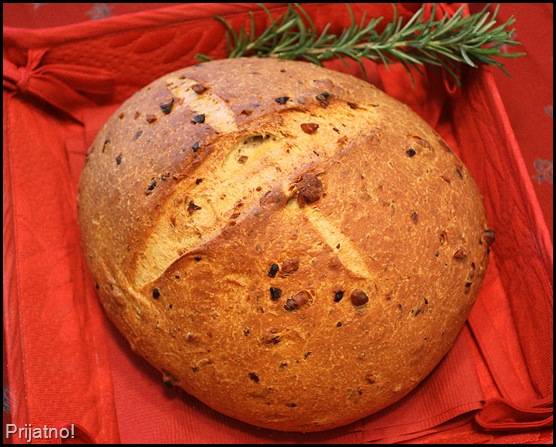
Walnut bread
Adapted from The Cheese Course by Janet Fletcher
Makes one 8-inch round loaf
1 cup walnuts
¼ ounce package active dry yeast, or 2½ teaspoons instant yeast
1/3 cup warm water (110ºF to 115ºF)
1 cup milk
1/3 cup unsalted butter, cut up into chunks
about 3 cups unbleached all-purpose flour
½ cup whole-wheat flour
2 teaspoons salt
1/3 cup minced shallots
2 tablespoons cornmeal
1 pound Humboldt Fog cheese
Preheat oven to 350ºF. Toast walnuts on a baking sheet until fragrant and lightly toasted, about 15 minutes. Let cool and then chop coarsely.
In a small bowl sprinkle the yeast over the warm water and let stand for 2 minutes to soften. Stir to dissolve and allow to sit for about 5 – 10 minutes, or until fine bubbles form on the surface. This means that the yeast is active and you have just ‘proofed’ it.
Heat the milk and butter in a small saucepan until butter is melted. Set aside to cool to about 110ºF.
In a large bowl, stir together 1¾ cups of the all-purpose flour, whole-wheat flour and salt. Add the active (proofed) yeast, milk and butter mixture, shallots and walnuts. Stir until well blended. Add more all-purpose flour gradually, stirring until the dough becomes too stiff to stir. Turn out onto a lightly floured board and knead until the dough is smooth and elastic, about 5 minutes, adding more flour as necessary.
Shape the dough into a ball and transfer to a large greased bowl (I use about 1 tablespoon olive oil). Turn the dough over to coat the entire surface with oil. Cover with a clean kitchen towel and let rise until doubled, about 1½ hours. Punch the dough down and transfer to a lightly floured work surface. Reshape into a ball and transfer to a baking sheet dusted with the cornmeal. Cover with the towel and let rise until doubled, about 1½ hours.
Preheat oven to 425ºF. Put a baking dish with ice water on the floor of the oven to create steam. Slash the loaf a couple of times, and then bake for 30 minutes. Reduce the oven temperature to 325ºF, remove the water from the oven and continue to bake bread until it is well browned, about 30 minutes more. Let cool on rack before slicing. Serve with sliced Humboldt Fog cheese and Onion Jam.
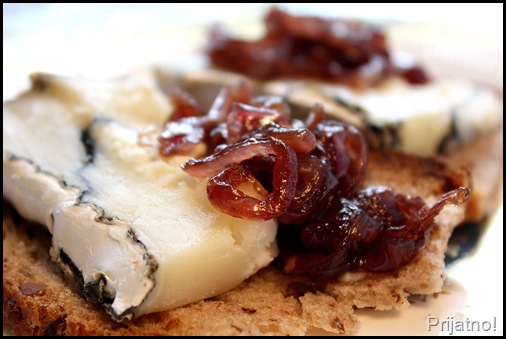
I am submitting this recipe to YeastSpotting, a weekly review of yeast-driven food. Check the link for some wonderful recipes!
Prijatno!
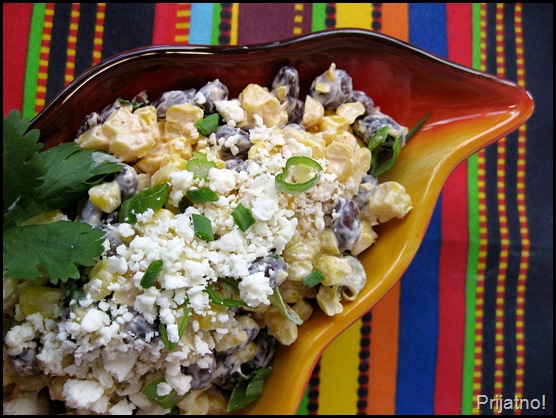 One of my favorite aromas is grilled sweet summer corn emanating from Hispanic food stands and taco trucks. Smoky and hot with the presence of a little char, roasted corn on the cob is becoming a common street food here in Texas as it is in Mexico. Known as elote, corn is usually roasted in its husk. When stripped but left attached at the end, the husk (also known as the shuck) becomes the handle with which one eats the corn. Slathered with mayonnaise, lime and chili powder, it is one toothsome treat!
One of my favorite aromas is grilled sweet summer corn emanating from Hispanic food stands and taco trucks. Smoky and hot with the presence of a little char, roasted corn on the cob is becoming a common street food here in Texas as it is in Mexico. Known as elote, corn is usually roasted in its husk. When stripped but left attached at the end, the husk (also known as the shuck) becomes the handle with which one eats the corn. Slathered with mayonnaise, lime and chili powder, it is one toothsome treat!
